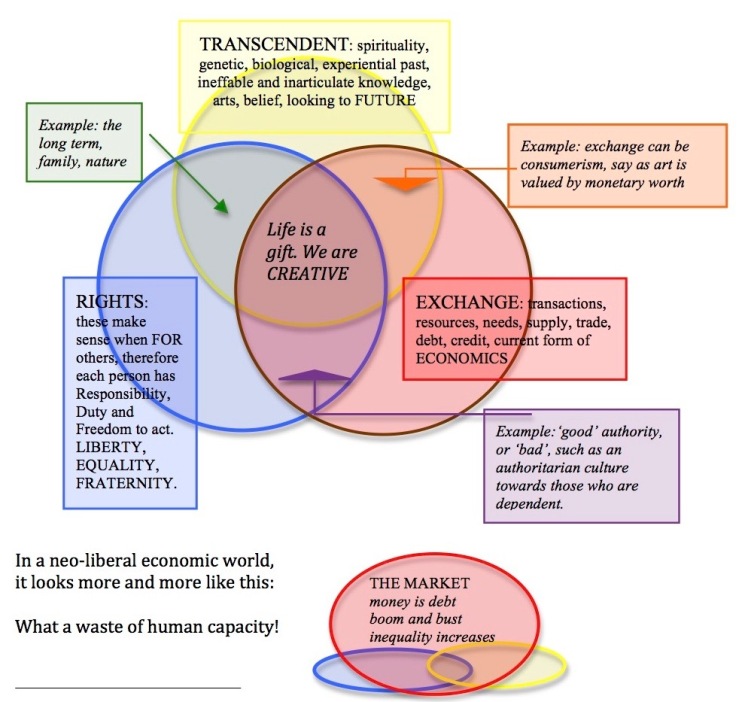How do we set about creating a system that would represent life better? Inadequate as it is, the Venn diagram below helps me think about how we can stop seeing money as only a means of transaction between people, helps me start from something more whole in human experience. There are three interlinked relationships within our life, expressed in many different ways and differently divided by other writers[i]. However they are expressed, all agree that without each and without each in combination, the picture of life fails in some important respect. Joseph Beuys[ii] proposed a basic foundation that encompassed what he called the Spiritual Life, the Rights Life and the Economic Life. A little differently, I consider the life of the transcendent, rights, and exchange[iii]. Suppose a foundation could look like this:

If we said the need was for a money idea that covered life needs, human and world in which we live, then it is not utopia to say this is a final objective, but on the way there will be lesser aims, transitional shifts. Whatever these are, they need to be seen to be stages in heading towards a monetary system that might be uncertain but would even so be more genuinely reaching for real requirements than the present pseudo-science that is too frequently taught as economics[iv]. The direction in which proposed change takes us matters.
In brief:
Could we, creative people, conceive of a money system that is like life?
What would money as gift look like?
[i] Interactions: see French, R. B., and P. Simpson. ‘The “Work Group”: Redressing the Balance in Bion’s Experiences in Groups’. Human Relations 63, no. 12 (1 December 2010): 1859–78; The Threefold Social Impulse: see Roesch, Ulrich. We Are the Revolution!: Rudolf Steiner, Joseph Beuys and the Threefold Social Impulse. Forest Row: Temple Lodge Publishing, 2013; add your own knowledge from whatever perspective e.g. ecology, religion, sociology, philosophy, etc.
[ii] Beuys, Joseph, ed. What Is Money?: A Discussion. Forest Row, England: Clairview Books, 2010.
[iii] This is roughly comparable to Wilfred Bion’s unconscious theory of group behaviours, pairing, dependency and fight/flight. see French and Simpson above for development of this idea as basic interactions.
[iv] References, many include:
Rowbotham, Michael. The Grip of Death: A Study of Modern Money, Debt Slavery, and Destructive Economics. Charlbury, Oxfordshire : Concord, MA: Jon Carpenter ; Distributed by Paul and Co, 1998.
Jackson, Andrew, Ben Dyson, and Herman E. Daly. Modernising Money: Why Our Monetary System Is Broken and How It Can Be Fixed. London: Positive Money, 2014.
Ivo Mosley, and Positive Money websites.
5 thoughts on “A new Paradigm for a new Monetary System [2]”